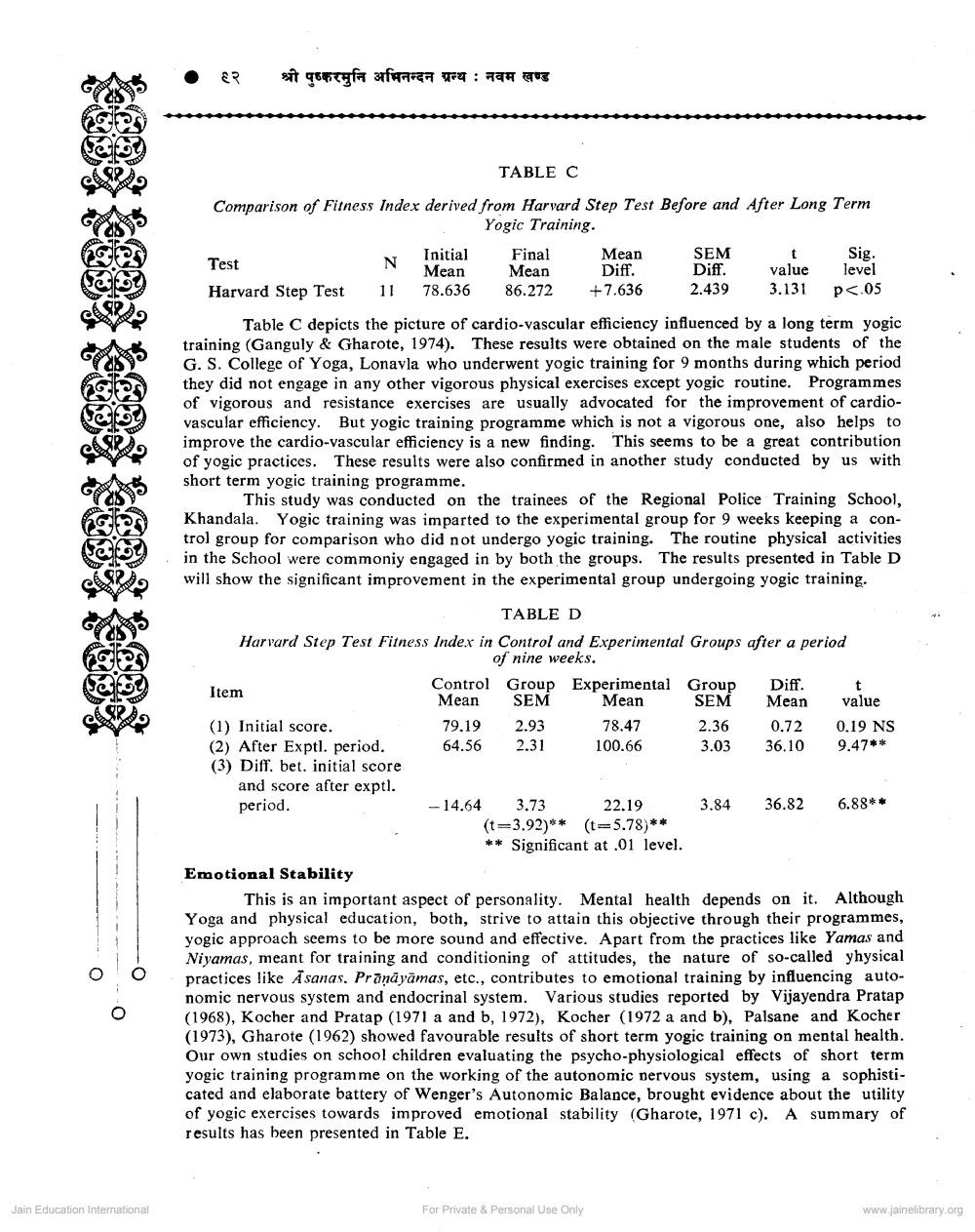Book Title: Yoga in Physical Education Author(s): M L Gharote Publisher: Z_Pushkarmuni_Abhinandan_Granth_012012.pdf View full book textPage 5
________________ स . ६२ श्री पुष्करमुनि अभिनन्दन ग्रन्थ : नवम खण्ड TABLE C Comparison of Fitness Index derived from Harvard Step Test Before and After Long Term Yogic Training. Initial Final Mean SEM t Test Sig. Mean Mean Diff. Diff. value level Harvard Step Test 11 78.636 86.272 +7.636 2.439 3.131 p<.05 Table C depicts the picture of cardio-vascular efficiency influenced by a long term yogic training (Ganguly & Gharote, 1974). These results were obtained on the male students of the G. S. College of Yoga, Lonavla who underwent yogic training for 9 months during which period they did not engage in any other vigorous physical exercises except yogic routine. Programmes of vigorous and resistance exercises are usually advocated for the improvement of cardiovascular efficiency. But yogic training programme which is not a vigorous one, also helps to improve the cardio-vascular efficiency is a new finding. This seems to be a great contribution of yogic practices. These results were also confirmed in another study conducted by us with short term yogic training programme. This study was conducted on the trainees of the Regional Police Training School, Khandala. Yogic training was imparted to the experimental group for 9 weeks keeping a control group for comparison who did not undergo yogic training. The routine physical activities in the School were commoniy engaged in by both the groups. The results presented in Table D will show the significant improvement in the experimental group undergoing yogic training. Neto 2 . Item TABLE D Harvard Step Test Fitness Index in Control and Experimental Groups after a period of nine weeks. Control Group Experimental Group Diff t Mean SEM Mean SEM Mean value (1) Initial score. 79.192.93 78.47 2.36 0.72 0.19 NS (2) After Exptl. period. 64.56 2.31 100.66 3.03 36.10 9.47** (3) Diff. bet. initial score and score after exptl. period. -- 14.64 3.73 22.19 3.84 36.82 6.88** (t=3.92)** (t=5.78)** ** Significant at .01 level. Emotional Stability This is an important aspect of personality. Mental health depends on it. Although Yoga and physical education, both, strive to attain this objective through their programmes, yogic approach seems to be more sound and effective. Apart from the practices like Yamas and Niyamas, meant for training and conditioning of attitudes, the nature of so-called yhysical practices like Asanas. Prānāyāmas, etc., contributes to emotional training by influencing autonomic nervous system and endocrinal system. Various studies reported by Vijayendra Pratap (1968), Kocher and Pratap (1971 a and b, 1972), Kocher (1972 a and b), Palsane and Kocher (1973), Gharote (1962) showed favourable results of short term yogic training on mental health. Our own studies on school children evaluating the psycho-physiological effects of short term yogic training program me on the working of the autonomic nervous system, using a sophisticated and elaborate battery of Wenger's Autonomic Balance, brought evidence about the utility of yogic exercises towards improved emotional stability (Gharote, 1971 c). A summary of results has been presented in Table E. Jain Education International For Private & Personal Use Only www.jainelibrary.orgPage Navigation
1 ... 3 4 5 6 7 8
